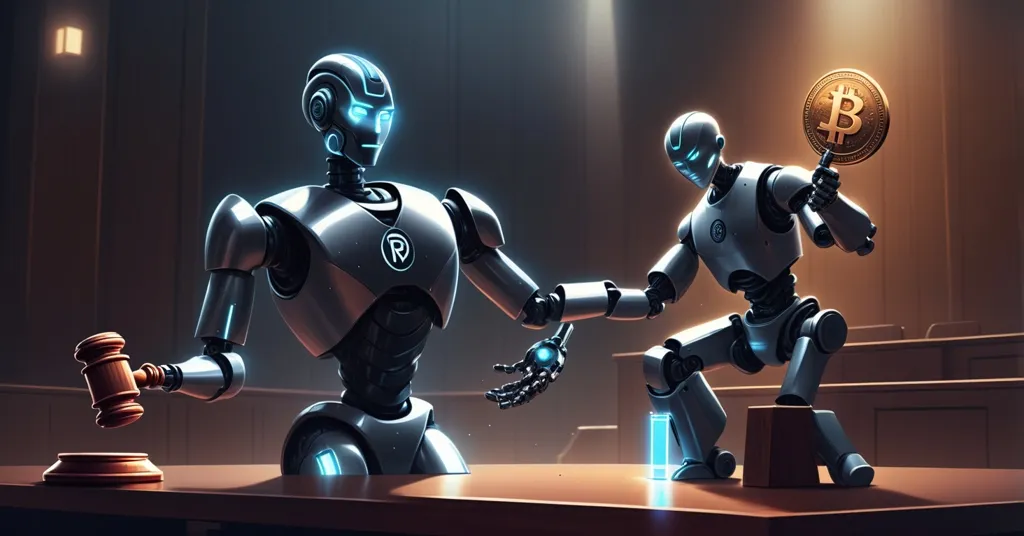Ripple-SEC Saga Stalls After July 10 Meeting: XRP Future Uncertain

Ripple vs. SEC: No End in Sight After July 10 Meeting—What’s Next for XRP?
The long-running legal showdown between Ripple and the U.S. Securities and Exchange Commission (SEC) remains unresolved following a much-anticipated closed-door SEC meeting on July 10. Despite fervent speculation within the XRP community that the agency might drop its appeal, no such decision emerged, leaving the nearly five-year battle in limbo and the future of XRP hanging in the balance.
- No Decision: The SEC meeting focused on unrelated enforcement matters, not Ripple’s case.
- Legal Limbo: Ripple dropped its cross-appeal, but the SEC’s next steps could take weeks or months.
- Market Movement: XRP’s price jumped over 5% to $2.56, fueled by speculation or broader trends.
The Stakes: Why Ripple vs. SEC Matters to Crypto
This isn’t just a corporate spat—it’s a defining moment for XRP securities classification and broader crypto regulation trends. Since the SEC sued Ripple in 2020, the core issue has been whether XRP, Ripple’s native token, qualifies as a security under U.S. law. A security, simply put, is a financial instrument like a stock or bond, where investors expect returns based on someone else’s efforts, and it requires strict registration and disclosure rules. The SEC alleges Ripple illegally raised hundreds of millions by selling XRP as an unregistered security, particularly through direct deals with big players like hedge funds—known as institutional sales. Ripple counters that XRP is more like a digital currency, free from such regulatory burdens, especially when sold on public exchanges to retail investors.
The outcome could set a precedent for how digital assets are classified, impacting not just XRP but potentially other major players like Ethereum or Cardano. A harsh ruling might bury crypto innovation under red tape, while a favorable one for Ripple could embolden projects to push boundaries without fear of regulatory hammers. This clash between the old guard of financial oversight and the new wave of decentralized money is why every development in this case sends ripples—pun intended—through the entire blockchain space.
What Happened (or Didn’t) at the July 10 SEC Meeting?
Leading up to the closed-door meeting, XRP supporters were buzzing with hope that the SEC might vote to drop its appeal against Ripple. This optimism wasn’t baseless—Ripple had already signaled a willingness to de-escalate by dropping its own cross-appeal last month. Some even pointed to a prior settlement agreement as a sign both sides might call a truce. But former SEC lawyer Marc Fagel’s commentary on the Ripple lawsuit and appeal process quickly doused those flames, noting that the meeting’s agenda was packed with unrelated matters like injunctive actions and administrative proceedings, none of which directly tied to Ripple.
Fagel also highlighted the grinding pace of SEC bureaucracy. Even if a dismissal were on the table, the process typically drags on for weeks or months. There’s a faint glimmer of speed here, though—he acknowledged that since the SEC previously voted to dismiss an appeal under a settlement framework in this case, things could move faster. But don’t hold your breath; expecting swift action from a government agency is like waiting for a sloth to sprint. For more on the meeting’s context, check the recap of discussions from July 10.
The Legal Battle So Far: Wins, Losses, and a Hefty Fine
Let’s rewind through the key punches in this nearly half-decade fight. The SEC filed its lawsuit in December 2020, accusing Ripple of raising over $1.3 billion through unregistered securities offerings. A pivotal moment came in July 2023 when Judge Analisa Torres delivered a split ruling. On one hand, she determined that XRP sales on public exchanges—think retail investors buying on platforms like Binance—didn’t meet the criteria for securities. That was a partial victory for Ripple. On the other hand, she ruled that institutional sales, where Ripple directly sold $728 million worth of XRP to big investors, were indeed unregistered securities, violating federal law. For a deeper dive into the case history, refer to the detailed background on Ripple Labs.
The consequences stung. Judge Torres issued an injunction barring Ripple from further violations and slapped the company with a $125 million fine. For perspective, that’s not a parking ticket—it’s a glaring signal that the SEC and courts aren’t messing around. Ripple CEO Brad Garlinghouse has tried to spin this as a win, publicly claiming the company prevailed. But let’s be real: getting hit with a nine-figure penalty and a legal leash isn’t victory by any stretch. Fagel didn’t mince words on this, pointing out the court’s adverse findings as proof Ripple took a serious hit. The impact of the $125 million fine by Judge Torres also reverberated through XRP’s market dynamics.
Judge Torres ruled that Ripple illegally raised hundreds of millions through unregistered securities sales, enjoined further violations, and ordered a $125 million fine.
Adding another layer of complexity, a recent court update shows Judge Torres rejecting a proposed 2025 settlement that would have vacated the injunction and reduced the penalty. Her reasoning was blunt: the public interest trumps any backroom deal between Ripple and the SEC. She emphasized that parties can’t just agree to ignore a court’s final judgment on legal violations, signaling that even mutual appeal withdrawals might not fully close this chapter. This stance underscores a broader message—courts won’t let crypto firms skate lightly, settlement or not. Stay updated with the latest details on the Ripple-SEC lawsuit post-July 10 meeting.
Market Reaction: XRP Price Spikes Amid Uncertainty
Despite the legal murkiness, XRP’s price has shown resilience—or perhaps speculative fervor. According to CoinMarketCap, XRP is trading at $2.56, up over 5% in the last 24 hours at the time of writing. As the fourth-largest cryptocurrency by market value, XRP holds a significant spot in the ecosystem, often pitched as a tool for fast, cheap cross-border payments via RippleNet, a system designed to rival outdated frameworks like SWIFT used by banks. Bitcoin, for all its decentralized purity, doesn’t directly tackle this niche, which is why XRP’s utility keeps it relevant despite the drama.
But what’s driving this price bump? Is it genuine optimism about a resolution, or just another hype wave fueled by social media rumors? Historical trends offer little clarity—XRP saw spikes and dips tied to earlier lawsuit milestones, like the 2023 Torres ruling, with no consistent pattern. Without concrete news, this 5% jump smells more like market noise than substance. And let’s be brutally honest: if anyone’s swearing XRP will hit $10 tomorrow based on this, they’re likely hawking snake oil. Ignore the shills and focus on the facts. For community perspectives, explore Ripple and XRP discussions on Reddit.
XRP’s Role: Centralized Utility vs. Decentralized Ideals
From a Bitcoin maximalist lens, I’ll lay it bare—Ripple’s setup doesn’t scream the kind of freedom and privacy that Bitcoin embodies. With its close ties to banks and a more centralized structure, XRP feels like a compromise to the ethos of permissionless money. Bitcoin is the untainted king of decentralization, and no amount of payment efficiency changes that. That said, I can’t deny reality: XRP fills a gap with RippleNet, enabling near-instant cross-border transactions at a fraction of traditional costs. Imagine a small business in Asia sending funds to Europe—XRP could save them days and hefty fees compared to wire transfers. Bitcoin isn’t built for that speed or institutional adoption, nor should it be.
Yet, there’s a flip side to XRP’s bank-friendly model. Critics argue that partnering with traditional finance undermines the very point of crypto as a disruptor. Why build a new system just to cozy up to the old one? It’s a fair jab, and one that keeps the tension between utility and ideology alive in this space. Different blockchains serve different purposes—Ethereum with its smart contracts, XRP with payments, Bitcoin with sovereignty—and that diversity strengthens the financial revolution, even if it’s not always a perfect harmony.
Industry Implications: A Precedent in the Making
Zooming out, the Ripple-SEC saga is a litmus test for crypto regulation in 2025 and beyond. If the SEC’s hardline stance holds, we might see a wave of enforcement actions targeting other tokens, stifling innovation under a mountain of compliance. Conversely, a softened position or Ripple-friendly resolution could signal open season for blockchain projects to experiment without constant fear of lawsuits. This case echoes past SEC battles—like the 2017 DAO report labeling some tokens as securities or the Kik Interactive lawsuit over unregistered offerings—showing a pattern of growing scrutiny that’s now hitting a fever pitch. Learn more about the SEC’s ruling impact on crypto through Ripple’s legal battle.
Interestingly, a broader shift might be brewing. Since the start of Donald Trump’s second term, the SEC has quietly dropped civil lawsuits against giants like Binance, Coinbase, and Kraken. Is this a sign of a friendlier crypto climate under new political winds? Possibly, though Ripple’s case—rooted in specific securities law violations and predating this apparent pivot—might not reap the same leniency. The agency’s silence on the matter leaves room for speculation, but one thing’s clear: the fight between regulators and innovators is far from over. Curious about broader implications? Check out insights on the Ripple case’s regulatory impact.
Devil’s Advocate: Is Ripple’s Strategy Backfiring?
Let’s play skeptic for a moment. Ripple’s public narrative—painting itself as a victim of regulatory overreach while Garlinghouse touts a supposed triumph—might be great for rallying the XRP community, but is it smart? That $125 million fine isn’t a minor speed bump; it’s a neon sign that the SEC and courts mean business. By pushing a “we won” story, Ripple risks alienating the very regulators they might need to negotiate with. On the other hand, this bold rhetoric could be a calculated move to pressure the SEC indirectly through public and investor support. It’s a high-stakes PR gamble, and whether it pays off or backfires remains to be seen.
Key Takeaways and Questions on the Ripple-SEC Drama
- What came out of the SEC’s closed-door meeting on July 10 regarding Ripple?
Nothing specific—the meeting tackled unrelated enforcement issues, not Ripple’s appeal or lawsuit status. - Is the end of the Ripple-SEC legal battle near?
Not yet. Ripple dropped its cross-appeal and a prior settlement exists, but the SEC’s dismissal process could drag on, and Judge Torres’ rejection of a revised 2025 settlement adds hurdles. - What did the court rule against Ripple, and what were the penalties?
Judge Torres found Ripple’s institutional XRP sales to be unregistered securities, hitting the company with a $125 million fine and an injunction against further violations. - Why did XRP’s price climb 5% to $2.56 despite no resolution?
Likely due to speculative hope for a favorable outcome or unrelated market momentum, though no solid news backs this uptick. - What could this case mean for the wider crypto landscape?
The final ruling or settlement might redefine how digital assets are regulated as securities, shaping the future for Ethereum, Cardano, and others while balancing innovation with investor safeguards.
What to Watch For Next
As this legal chess match drags on, several developments loom on the horizon. Keep an eye out for any SEC announcements on appeal decisions, which could drop in the coming weeks or months. Upcoming court filings or statements from Ripple’s legal team might also hint at their next moves, especially after Judge Torres’ firm stance on public interest over settlements. Beyond that, XRP’s price volatility and adoption in cross-border payments will remain key indicators of market sentiment, regardless of courtroom outcomes. The stakes couldn’t be higher—not just for Ripple, but for the vision of decentralized finance as a whole. Patience, as always in the blockchain world, is the name of the game.



